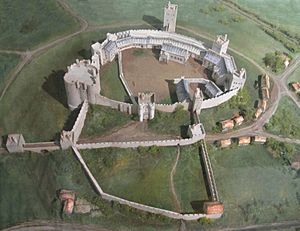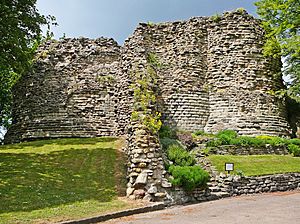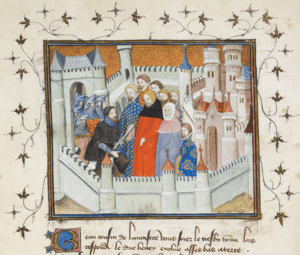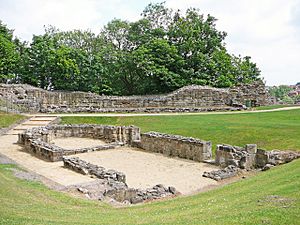Pontefract Castle facts for kids
Pontefract Castle is a very old castle ruin in the town of Pontefract, in West Yorkshire, England. Many important events happened here, including the suspected death of King Richard II. The castle was also the site of several famous battles during the English Civil War in the 1600s.
Contents
History of Pontefract Castle
Pontefract Castle was built around 1070 by a man named Ilbert de Lacy. He received the land from William the Conqueror as a reward for his help during the Norman Conquest. At first, the castle was made of wood. Over time, it was rebuilt using strong stone. The Domesday Survey of 1086, a famous record book, mentioned "Ilbert's Castle," which was probably Pontefract Castle.
The de Lacy family owned the castle for many years. However, one of them, Robert de Lacy, did not support King Henry I. Because of this, the King took the castle away from the family in the 1100s. Later, Roger de Lacy paid King Richard I a lot of money to get the land back. King Richard kept the castle itself.
In 1199, King John gave the castle back to Roger de Lacy. The de Lacy family lived in the castle until the early 1300s. During their time, they built a magnificent, multi-lobed tower called a donjon.
In 1311, the castle became part of the House of Lancaster through marriage. Thomas, Earl of Lancaster, was executed outside the castle walls in 1322 by King Edward II. This made him a hero, and his tomb became a special place. The castle then passed to Henry, Duke of Lancaster, and later to John of Gaunt. John of Gaunt, who was King Edward III's son, made the castle his home and spent a lot of money making it even better.
King Richard II's Story
Towards the end of the 1300s, King Richard II sent Henry Bolingbroke, John of Gaunt's son, out of England. When John of Gaunt died in 1399, King Richard II took much of the property that should have gone to Henry Bolingbroke. Pontefract Castle was one of these properties.
This made Henry Bolingbroke very angry. He returned to England to claim what was rightfully his. King Richard II was in Ireland at the time and could not stop him. Henry Bolingbroke quickly took over and became King Henry IV.
King Richard II was captured by Henry Bolingbroke's supporters in August 1399. He was first held in the Tower of London. Sometime before Christmas that year, he was moved to Pontefract Castle. He stayed there under guard until he died, possibly on February 14, 1400.
Historians have different ideas about how Richard II died. Some believe he was starved to death by his captors, while others think he starved himself. One old French writer suggested he was hacked to death, but this is probably not true.
King Richard III's Time
In 1483, King Richard III had two relatives of Elizabeth Woodville executed at Pontefract Castle. They were her son, Sir Richard Grey, and her brother, Anthony Woodville, 2nd Earl Rivers.
The Tudor Era
In 1536, the person in charge of Pontefract Castle, Thomas Darcy, 1st Baron Darcy de Darcy, gave the castle to the leaders of the Pilgrimage of Grace. This was a rebellion by Catholics in northern England against King Henry VIII. Lord Darcy was later executed because the King saw his surrender as an act of treason.
A Royalist Stronghold
Pontefract Castle was very important during the English Civil War in the 1600s. It was controlled by the Royalists, who supported King Charles I.
The first of three sieges (when an army surrounds a castle to try and capture it) began in December 1644. It lasted until March 1645, when Royalist soldiers arrived and the Parliamentarian army had to leave. During this siege, parts of the castle were damaged by mining and cannons.
The second siege started soon after, in March 1645. The Royalist soldiers inside the castle gave up in July after hearing that King Charles I had been defeated. Parliamentarian soldiers then guarded the castle until June 1648. At that point, Royalists secretly entered the castle and took control again. Pontefract Castle became a key base for the Royalists, who used it to attack Parliamentarian forces in the area.
Oliver Cromwell, a famous Parliamentarian leader, led the final siege of Pontefract Castle in November 1648. King Charles I was executed in January 1649. The soldiers defending Pontefract Castle finally agreed to surrender. Colonel Morrice handed the castle over to Major General John Lambert on March 24, 1649.
After requests from the townspeople and military leaders, Parliament ordered that Pontefract Castle be "totally demolished & levelled to the ground" on March 27, 1649. Materials from the castle were sold off. This destruction is why the castle is now mostly ruins.
You can still visit the castle's 11th-century cellars today. These were used to store military equipment during the Civil War.
Preserving the Castle
Not much is left of what was once "one of the most impressive castles in Yorkshire." You can still see parts of the outer walls and some inner walls that have been uncovered. The castle had inner and outer courtyards. Some of the oldest parts include a 12th-century wall, a small gate called the Piper Tower's postern gate, and the foundations of a chapel. The ruins of the Round Tower, or keep, stand on the original 11th-century mound. The main entrance, called the Great Gate, had two round towers and extra defenses.
Pontefract Castle has some very unusual features. Its main tower, the donjon, has a rare four-leaf clover shape, known as a quatrefoil design. Other castles with this design include Clifford's Tower in York, England, and the Château d'Étampes in France.
The castle also has a torre albarrana, which is a type of detached tower rarely seen outside of Spain and Portugal. This tower, called the Swillington Tower, was connected to the north wall by a bridge. It helped defenders shoot at attackers from the side.
Wakefield Council, who owns the castle, started repairs in 2015. After some delays, a new visitor centre and cafe opened in July 2017. On Yorkshire Day in 2019, the restoration work was finished. The castle was then removed from Historic England's "Heritage At Risk" list, meaning it is now safer and better preserved for everyone to enjoy.







